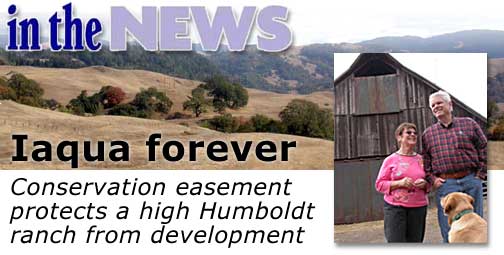|
|
 Welcome, my son |
|
story & photos by HEIDI WALTERS
Above: Carole and Francis Carrington and their dog Sam at
Iaqua Ranch.
A handful of real estate agents, a shopping mall maven and some environmentalists stood atop an expansive hillside with unbroken views to Heaven and beyond last Thursday -- a-ha, we know what you're thinking. But you're wrong. This wasn't a modern-day battle for the last best place, an ideological fight to the death 'tween landowner/developer-wannabes and land lover/let-it-bes. No. You've been riding those stereotypes too long. This hilltop gathering was, rather, a quite amiable handshake, a deliriously happy (you might say) celebration of an arrangement in which all agreed on one point: This land, this privately owned 4,700 acres of cattle-grazed, deer-nibbled, predator-haunted vastness of forests and grassland should remain forever thus.



At the top of yet another twisty turn in the skinny road winding up, down, up and inland into the wide-sky grassy section of Humboldt past Kneeland, the van stopped and the car-sick and weary crawled out to stretch and listen. Heat -- so foreign to the fogbound coast -- soaked everything, sky to ground, and from the sweet-smelling, pale dry grass on a slope leading to a stock pond a meadowlark trilled repeatedly. The soft hills soared and dropped all around: acres of grass interrupted by bands of oak woodlands in the lower reaches and forests of Doug fir and other conifers in the higher elevations. The N. Fork of Yager Creek meandered through one of the deep creases, where big-leaf maples were taking on a bright yellow tint, its water rusty with tannins from the autumn drop of oak leaves.
After nearly an hour of slow, tortuous ascent -- just a dozen or so miles from the redwoods, as the crow flies -- we were finally on the edge of the old Fulton Ranch, now owned by Francis and Carole Carrington. We'd driven through deciduous forests and over creeks, encountering several black-tailed deer along the way, some crossing the road in a hurry, others slowly, still spotted and naïve. Once, we'd come around a bend to the sight of a young cowpoke poised on his horse amid a band of slow cows. We'd spotted a few kestrels, and as we approached the viewpoint above the stockpond -- water suspended in a round hilltop pool, reflecting rain clouds streaked with blue -- a white egret coasted onto its surface.
This was a celebratory tour of a new conservation easement, a chance for the Northcoast Regional Land Trust (NRLT) to show what four years of negotiating bureaucratic trails, winning over donors and assembling the paperwork can achieve: the preservation of the 4,700-acre Iaqua Ranch as a working cattle ranch, in perpetuity. The conservation easement is an agreement between the Carringtons, who bought the ranch in 2002, and the state. The property owners relinquish their, and subsequent owners', right to subdivide and develop the property in exchange for some money and lower taxes. The owners will be allowed to continue working the ranch -- hunting, fishing, raising cattle (in a way that doesn't degrade streams or soil) and cutting timber (no clear-cutting allowed, nor any streamside logging, and only 25 percent of the timber can be cut each decade). The California Department of Forestry will hold the easement, and the NRLT will keep an eye on the land to make sure its conservation values remain protected, said the trust's Shayne Green.
The Iaqua easement is part of the NRLT's Six Rivers to the Sea effort to conserve working ranch lands and water resources from the Six Rivers National Forest down to the coast in Humboldt, Del Norte and Trinity counties. The first easement was on Steve Hackett's family's Howe Creek Ranch near Ferndale, in 1995. Six more easements are in the works that could amount to 25,000-plus acres, says the NRLT's Erik Wilson. NRLT paid the Carringtons $3.5 million for the easement, using funds from the state Wildlife Conservation Board, the federal Forest Legacy Program and the state's Forest Legacy Program, plus grants from Humboldt County and a few individuals. The easement was valued at $4.1 million, says Wilson -- the Carringtons donated the remaining $635,000.
Further down the road at the Iaqua Ranch house (site of a cavalry fort in the mid-1860s), the Carringtons -- who actually live over in Butler Valley and hire hands to caretake Iaqua and tend its 200 cattle -- waited for us. Francis, standing on the porch holding a red and white coffee cup, said he first saw Iaqua about 25 years ago when he was driving through the mountains on the back road to Bridgeville. He knew he wanted to buy it someday -- and finally did. "I fell in love with it," he said.
A couple of years after the Carringtons had bought the ranch, land owner and land agent Steve Hackett, of the Howe Ranch, and Mock Wahlund, a real estate agent who happened to have roamed the Iaqua ranch as a kid, asked them if they had considered a conservation easement.
Hackett, standing near the porch, said he didn't really try to get into the business of helping broker conservation easements on ranches. Back then, it was a pretty wild way for a rancher around here to be thinking. And he didn't even have a land trust to work with at the time. "I was pushing the envelope on it," he said. But he said he saw a dreaded future: former working ranches and private timberlands, hit by increased regulations and hard times, broken into unworkable bits and peppered with low-density housing. "I liken it to the loss of the Great Plains and the buffalo," Hackett said. "If you'd have said, back then, that there would be no buffalo some day, people would have laughed and laughed. But all you have to do is look [and see it happening already]. But people aren't looking."
Amid this conversation, the name of developer Robert McKee came up momentarily as evidence of this other scenario: McKee has been in a legal battle with the county over his decision to subdivide Southern Humboldt's Tooby Ranch. The real estate men on the tour of Iaqua were reluctant to judge. Wahlund, who represented the Carringtons in the easement, said he can see McKee's side of it. "He has the right to do what he wants to do with his property," he said.
Rancher Hackett, however, said that without a conservation easement on his land, it likely would end up being priced beyond what his offspring could afford to keep up. "My own motivation [at Howe Creek Ranch] had to do with the problem of transferring my land and keeping it in the family," Hackett said.
For Francis Carrington, a successful shopping mall developer, money wasn't the issue. "It was the beauty of it," he said.
A couple of days after the tour, Wahlund, who works with Coldwell Banker/Cutten Realty in Eureka, explained his own interest in Iaqua. His family's 640-acre ranch, also called Iaqua, is about a 15-minute horseback ride over the hill from the Fultons' Iaqua Ranch. The families' dads were buddies, and the kids wandered the hills together on foot and horseback. "That was the first place I went fishing," said Wahlund, who was born in 1947. He was about 6 years old at the time. "We'd catch trout down there [in Yager Creek]. So, I have good memories of it."
Wahlund said he knows that some ranchers still look askance at conservation easements, and being a conservative fellow himself, he understands where they're coming from even if he thinks they're sometimes not fully informed about what conservation easements really do. "Iaqua is under the microscope right now," he said. "There's this perception that conservation easements are open doors for government intrusion. I've had numerous other ranchers call us. They say, `What's going to happen at Iaqua?' and `Why are you doing that?!' And I say, `I love that ranch!'"
Wahlund and Carrington told the skeptics that under the easement Iaqua could never be developed, but it would always be privately owned and would continue to be operated as a cattle ranch.
"That's the beauty of this place," Wahlund said. "It will never be developed. It's pristine. Its highest and best use is ranching. It's got a lot of water -- it's all run by hydropower. It's got the headwaters of Yager Crick -- you've got three major cricks, Dairy Crick, Butte and Ellison. It's got southern exposure. It's close to town. The winter here you could still run cattle; it only snows on half of it. It's just one-of-a-kind. I'm really happy knowing it's going to be a 4,700-acre lot when I'm gone. Yeah, it's just a little piece of heaven up there. Anyone who's been there comes away with a good feeling."
COVER STORY | IN
THE NEWS | STAGE
MATTERS | OFF
THE PAVEMENT
ARTBEAT | TALK OF THE TABLE | THE HUM | CALENDAR
Comments? Write a letter!
© Copyright 2006, North Coast Journal, Inc.

